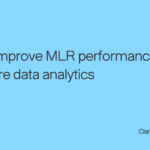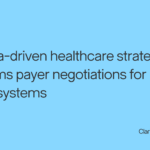Controlling costs while maintaining high-quality care is a constant challenge for health plans – especially for specialty populations. Recent data shows that specialty care represents over 50% of medical expenditures in the United States. One innovative approach gaining traction among health plan decision-makers is value-based care (VBC). VBC focuses on rewarding healthcare providers based on patient health outcomes rather than the volume of services rendered. This model is particularly beneficial for specialty populations with complex and high-cost care needs. VBC models can help health plans and small self-insured employers reduce claims spent for specialty populations by supporting cost-effective, high-quality care. However, this requires accurate and timely insights into costs, care delivery trends, patient outcomes, and other metrics. That’s where healthcare data analytics can help. The right analytics platform can provide granular levels of transparency that health plans and employers can use to identify the best and most efficient care pathways for specialty populations. As value-based care continues to make inroads in the American healthcare system, it’s vital to understand precisely how it can help reduce claims spend while supporting more effective care—and the role of data analytics in these efforts. Specialty care populations generate a vast array of complex data from numerous sources. The sheer volume and variety of this data can present significant challenges to health plans in terms of management and integration. Because of this, ensuring data quality and integrity is crucial. Inaccuracies or inconsistencies can lead to incorrect analyses, ultimately impacting care decisions and financial outcomes. Moreover, achieving interoperability—where different healthcare systems can seamlessly communicate, exchange and integrate data—is another hurdle. Without interoperability, the full potential of data analytics cannot be realized, as data remains siloed and difficult to utilize in a comprehensive manner. For payers, access to robust and accurate data analytics is crucial for predicting the most effective treatments for specific patient populations. By identifying which treatments yield the best outcomes, analytics help prevent ineffective treatments and unnecessary procedures, reduce wasteful spending, and lowering the total cost of care. Data analytics is crucial in predicting the most effective treatments for specific patient populations. By identifying which treatments yield the best outcomes, analytics help prevent the incidence of ineffective treatments and unnecessary procedures, directly impacting claims expenses. This predictive capability is invaluable in a VBC model, as it aligns with the goal of providing high-quality, cost-effective care. Four out of ten Americans suffer from two or more chronic conditions, which often require them to see several specialists. Other specialty populations, such as children, disabled individuals, and pregnant women, may see several providers as a matter of course. Without proper care coordination, this can lead to a fragmented care experience – often leading to unnecessary, redundant, or contraindicated tests and treatments. Coordinated care under a VBC model ensures that treatments are necessary and appropriate, avoiding duplications and inefficiencies. This level of care coordination is essential for optimizing the patient experience and outcomes, while also directly decreasing claims costs by reducing unnecessary services. Healthcare data analytics are instrumental in tracking the entire patient care pathway and identifying any overlaps or gaps in care. By highlighting these areas, health plans can work towards streamlining care delivery, ensuring that patients receive the right care at the right time. This optimization enhances patient outcomes and can help uncover where there might be overlaps or gaps to optimize care even further and reduce claims costs, leading to a significant reduction in claims spend. Healthcare shouldn’t be a one-size-fits-all approach. Specialty populations often have unique health needs that require personalized care plans. Traditional care models may not adequately address these needs, leading to poor outcomes and higher costs. A patient-centered care approach under VBC focuses on tailoring care plans to individual patient needs, which is crucial for improving outcomes and controlling costs. Implementing patient-centered care models ensures that treatments align more closely with individual health needs. This alignment can result in quicker recovery times, fewer complications, and a reduced need for expensive, repeated interventions. Consequently, this approach helps minimize overall claims spending, as patients require less intensive and prolonged care. Healthcare data analytics can provide deep insights into patient behaviors and treatment responses, allowing for more accurate and predictive intervention tailoring. By understanding these patterns, healthcare providers can offer more effective care, reducing unnecessary claims and enhancing patient satisfaction. Traditional fee-for-service models emphasize patient volume, offering little motivation for providers to focus on efficiency or optimal patient outcomes. In contrast, value-based care incentivizes providers who can show evidence of delivering high-quality, effective care. This can include preventative treatments, programs that help patients manage chronic conditions, and remote patient monitoring, which can help reduce the need for frequent appointments or more expensive interventions. Data analytics can help providers monitor progress in specialty populations and identify areas for improvement, both for individual patients and in aggregate. This allows them to continuously optimize care delivery for efficacy and cost efficiency and reveal best practices that can improve health outcomes and lower costs across patient populations. Rising healthcare costs, a growing population of aging patients with complex needs, and an increasingly stringent regulatory environment are just a few factors driving the adoption of value-based care. By leveraging robust data analytics, fostering integrated care coordination, implementing patient-centered care models, and realigning provider incentives, VBC can lead to significant reductions in claims spend. For health plan decision-makers, embracing VBC is not just a cost-saving strategy; it’s a commitment to providing high-quality, patient-centered care that benefits all stakeholders in the healthcare ecosystem. Making sense of diverse data with robust data analytics
VBC and integrated care coordination
Patient-centered care models through value based care
Better incentives for provider engagement
Specialty population care can be value based care
- Author Details





